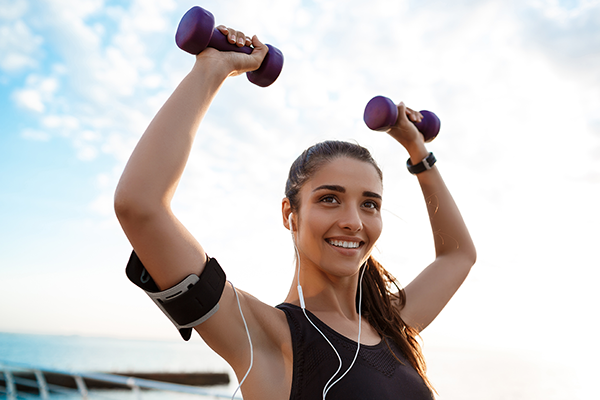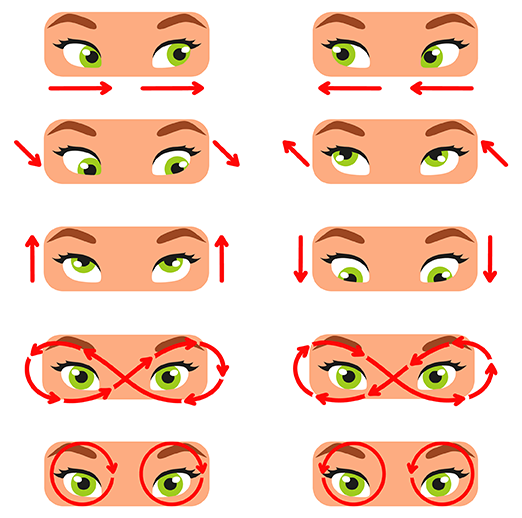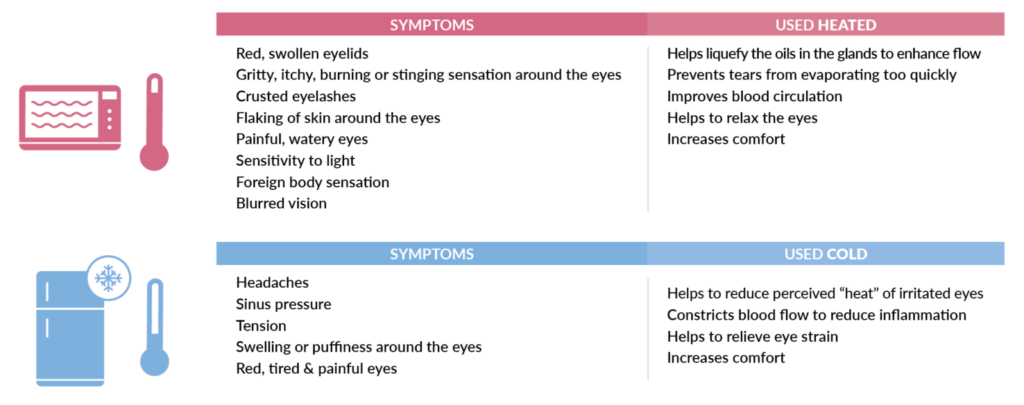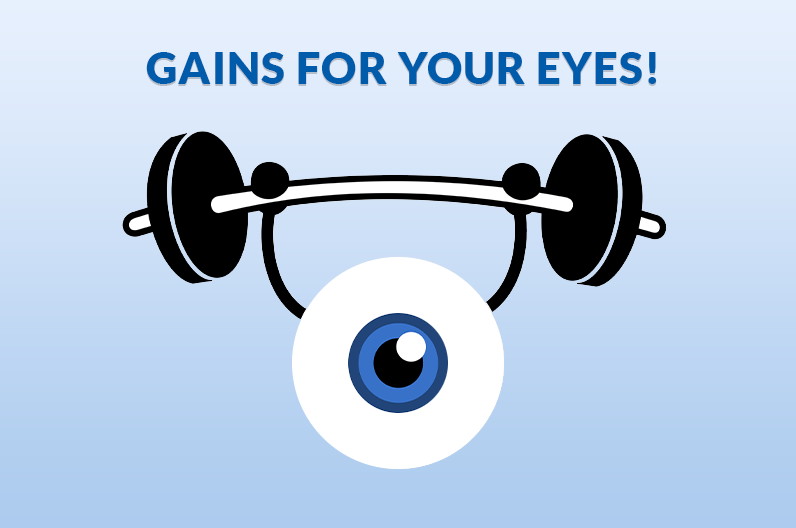(I-MED Pharma)
It’s well-known that physical activity is good for overall health, but did you know that physical exercise can also help improve symptoms of dry eye? And more than that, that there are specific eye exercises that may help improve ocular function? Interestingly enough, it seems as though exercise may help reduce inflammation in cases of dry eye and help relieve symptoms of ocular fatigue in cases where dry eye is caused by digital strain.
Exercise and dry eye: the science

Can hitting the gym help relieve symptoms of dry eye? The idea may sound a bit far-fetched, but a 2022 study titled, “Differential effect of maximal incremental treadmill exercise on tear secretion and tear film stability in athletes and non-athletes” led by researchers from the University of Waterloo did in fact find a significant increase in tear secretion and tear film stability after participating in aerobic exercise. [1] They concluded that physical activity can be another remedy for relieving dry, itchy eyes. The reason being is that aerobic exercise affects intraocular pressure, ocular blood circulation, anterior chamber depth structures, and visual function. [2] It has also been demonstrated to increase tear secretion and reduce inflammation, which is incredibly relevant, seeing as one of the leading symptoms of dry eye is inflammation. Additionally, in 2023, the literature surrounding physical activity and dry eye was reviewed in order to identify the association between the two factors. The authors also concluded that despite the diverse groups of people that were studied and the diverse designs and methods of the studies, the current body of literature does in fact suggest a potential role for physical activity to be a stimulus for proper functioning tear film and/or relief of dry eye symptoms. [3]
This research then begs the question–if physical exercise helps dry eye disease, does a lack of exercise cause dry eyes? In 2023, a group of researchers assessed over 48,000 participants to understand this relationship better. They concluded that greater sedentary time was tied to an increased risk of dry eye disease, especially for those with lower physical activity than the World Health Organization’s recommendations. However, as there was no significant association when computer-intensive sitting time was excluded, screen use could explain the observed relationship and should be noted as a possible key confounder. [4] This then reinforces the idea that dry eye disease is a multifactorial disease, meaning multiple factors can come into play when discussing the causation of the disease. However, it is still important to note that while physical activity can help improve symptoms of dry eye disease, there is a lack of evidence that suggests a lack of exercise causes dry eye.
Eye exercises for dry eyes
There are more ways to workout that are beneficial for your eyes, and it doesn’t have to involve a treadmill! There is an increasing popularity in doing eye exercises for dry eyes. For example, eye yoga focuses on strengthening the muscles around the eyes, as well as relieving ocular fatigue. [5] Eye yoga benefits range from relieving eye strain, to improving visual reaction time.
Types of eye yoga exercises
A 2016 study titled “Effects of yogic eye exercises on eye fatigue in undergraduate nursing students” found that yogic eye exercise may relieve eye fatigue levels. [6] The study focused on the following eye exercises:
 Palming: palming relaxes and revitalizes the eye muscles and stimulates the circulation of the aqueous humor, the liquid that runs between the cornea and the lens of the eye, aiding the correction of defective vision.
Palming: palming relaxes and revitalizes the eye muscles and stimulates the circulation of the aqueous humor, the liquid that runs between the cornea and the lens of the eye, aiding the correction of defective vision.
Blinking: the blinking exercise encourages the blinking reflex to become spontaneous, inducing relaxation of the eye muscles.
Sideways viewing: sideways viewing relaxes the tension of muscles strained by constant reading and close work, preventing and correcting squint; front and sideways viewing improves the coordination of medial and lateral muscles.
Front and sideways viewing: front and sideways viewing improves the coordination of medial and lateral muscles.
Rotational viewing: rotational viewing restores balance in the muscles surrounding the eyes and improves the coordinated activity of both eyeballs.
Up and down viewing: up-and-down viewing balances the upper and lower eyeball muscles.
Preliminary nose-tip gazing: preliminary nose-tip gazing improves the accommodating and focusing power of the eye muscles.
Near and distant viewing: near and distant viewing are like the preliminary nose-tip gazing exercise, but the range of movements is further increased.
Each step was performed for 5 minutes per cycle. After the eye exercises, the participants practiced the Shavasana (corpse pose) for 20 minutes to relax their eyes.
 Lifestyle changes to naturally curb dry eye symptoms
Lifestyle changes to naturally curb dry eye symptoms
On top of exercises for dry eye, there are other natural ways to help improve symptoms of dry eye disease. For example, dry eye disease can result from prolonged screen use, and so aiming to reduce digital eye strain would be an efficient way to help relieve certain symptoms. If your eyes are constantly working overtime from hyper-focusing and high levels of screen time it would be important to rework your routine to include some breaks where you can rest your eyes.
💡Hint: The 20/20/20 rule: For every 20 minutes working on a screen, look across the room (about 20 feet away) for 20 seconds.
Additionally, during dry eye flare ups or other instances of inflammation and pain from dry eye disease, a hot or cold compress can help. I-RELIEF™️ is an eye mask for dry eye from I-MED Pharma that can provide moist heat therapy as well as cold therapy.

 Supplements for the mind, body and eyes
Supplements for the mind, body and eyes
While exercise is incredibly important for a healthy body and mind, nutrition is equally as important. Consuming the proper nutrients is integral for the body to function at its proper capacity. In the case of those who are suffering from dry eyes, omega-3s are an incredibly important supplement to consume to help curb symptoms of dry eye. Omega-3s for dry eyes are not only great for cognitive function and overall body health, but they can also help relieve dry eye symptoms and promote tear film production in adults.
💡Hint: Try I-VU® OMEGA-3 PLUS capsule supplement to see how omega-3s can help you on your dry eye journey. Or, try our alternative to capsules: our omega-3 liquid supplement.
Mental health is wealth
To heal the body is to heal the mind and vice versa. Implementing ways of wellness, no matter how small, can help improve quality of life and ease dry eye symptoms. Although symptoms are directly physical, they can end up affecting your mental health. It’s important to take these symptoms equally as seriously, which is why treating the eyes will also help treat the mind.
💡Hint: Communication is key. Having the right kind of support system is important, whether talking to a friend or loved one, or taking time to exercise moments of wellness.
To learn more, find a clinic near you to speak to an eye care professional that carries I-MED Pharma products.
[1] ScienceDaily. (2022, February 3). Exercise can provide relief for dry, Itchy Eyes. ScienceDaily. https://www.sciencedaily.com/releases/2022/02/220203083607.htm
[2] Abokyi, S., Nyamaah Mensah, S., Otchere, H., Osei Akoto, Y., & Ntodie, M. (2021, November 27). Differential effect of maximal incremental treadmill exercise on tear secretion and tear film stability in athletes and non-athletes. Experimental Eye Research. https://www.sciencedirect.com/science/article/abs/pii/S0014483521004310?via%3Dihub
[3] Navarro-Lopez, S., Moya-Ramón, M., Gallar, J., Carracedo, G., & Aracil-Marco, A. (n.d.). Effects of physical activity/exercise on tear film characteristics and dry eye associated symptoms: A literature review. Contact lens & anterior eye : the journal of the British Contact Lens Association. https://pubmed.ncbi.nlm.nih.gov/37173175/
[4] Veho, J., Hammond, C. J., Uthei, T. P., Magno, M. S., & Nguyen, L. (2023, January 5). The relationship between sedentary behavior and dry eye disease. The Ocular Surface. https://www.sciencedirect.com/science/article/pii/S1542012423000022
[5] Eye yoga. Diagnose and treat your dry eye. (2023, February 28). https://mydryeyedisease.com/eye-yoga/
[6] Kim, S.-D. (2016, June). Effects of yogic eye exercises on eye fatigue in undergraduate nursing students. Journal of physical therapy science. https://www.ncbi.nlm.nih.gov/pmc/articles/PMC4932063/



 Palming: palming relaxes and revitalizes the eye muscles and stimulates the circulation of the aqueous humor, the liquid that runs between the cornea and the lens of the eye, aiding the correction of defective vision.
Palming: palming relaxes and revitalizes the eye muscles and stimulates the circulation of the aqueous humor, the liquid that runs between the cornea and the lens of the eye, aiding the correction of defective vision. Lifestyle changes to naturally curb dry eye symptoms
Lifestyle changes to naturally curb dry eye symptoms
 Supplements for the mind, body and eyes
Supplements for the mind, body and eyes